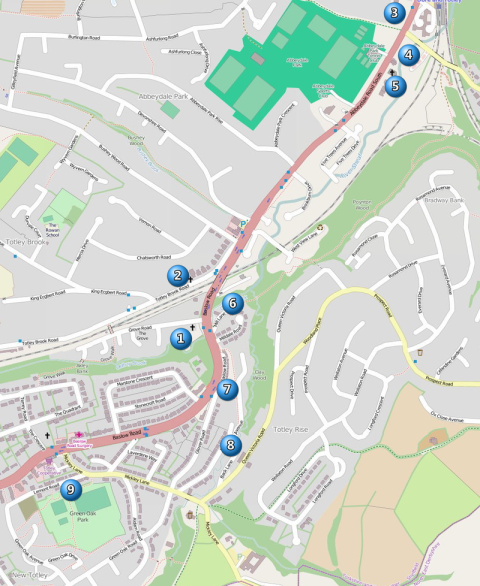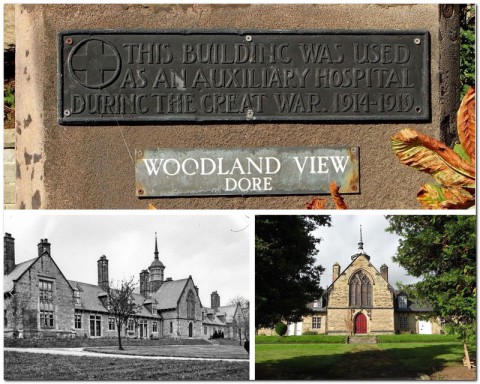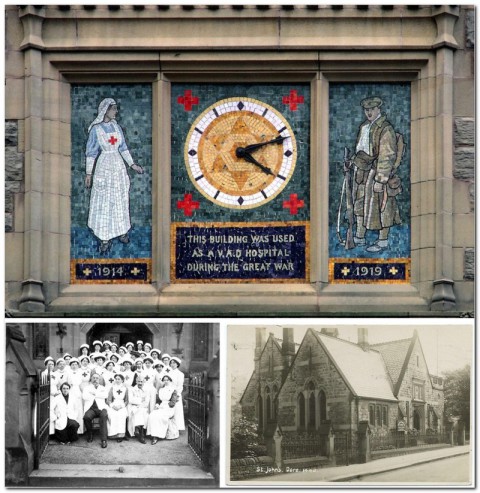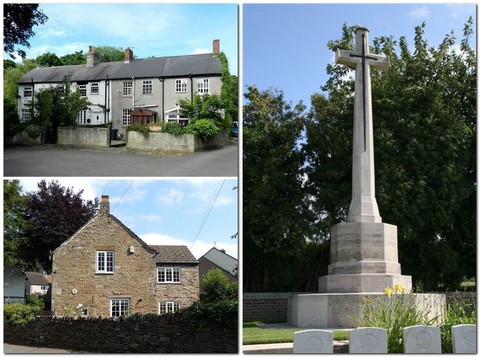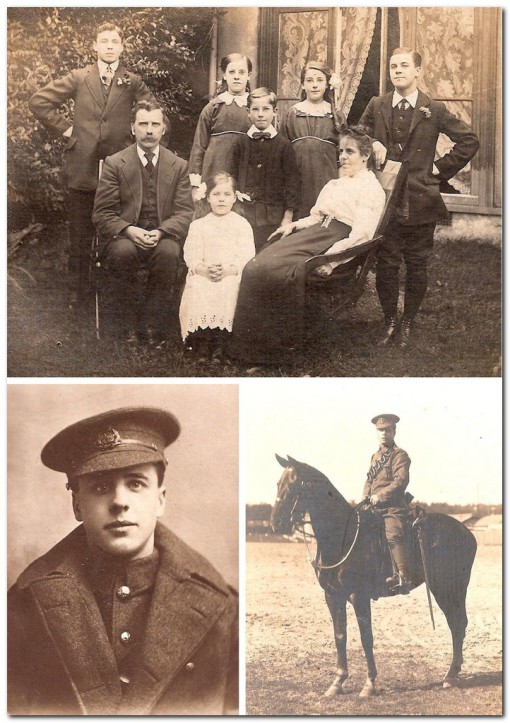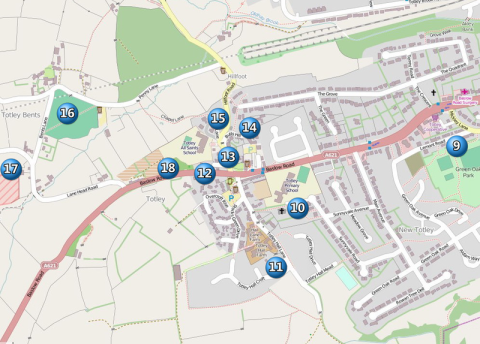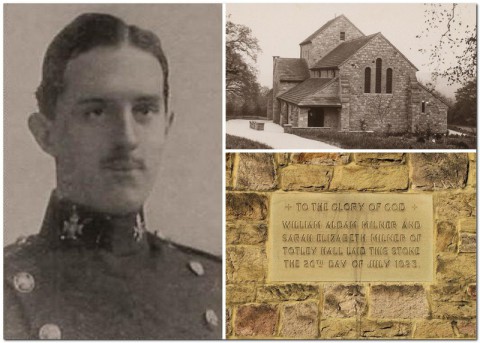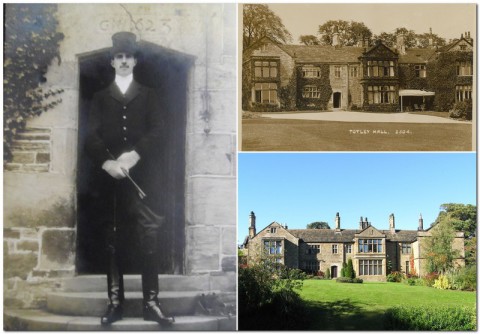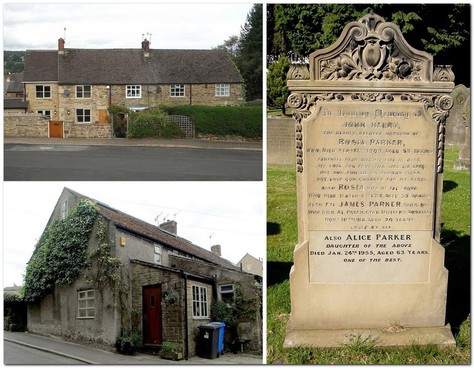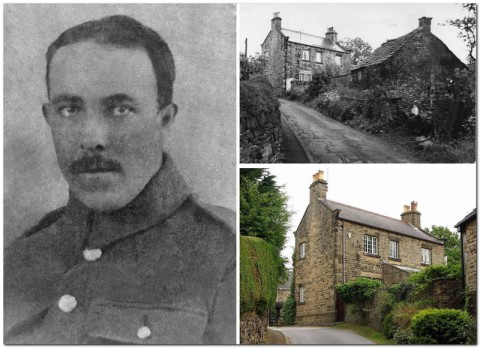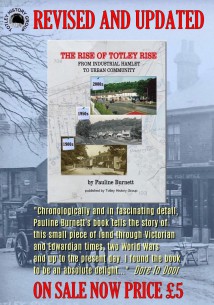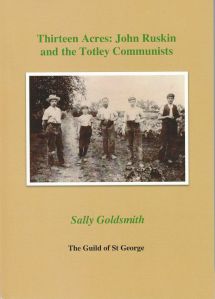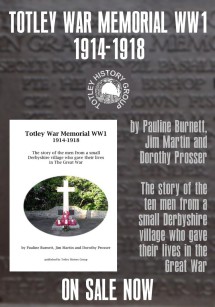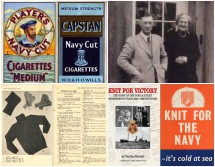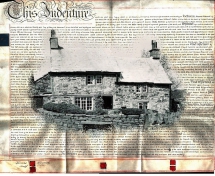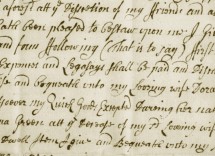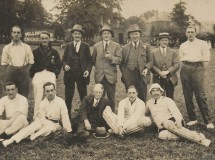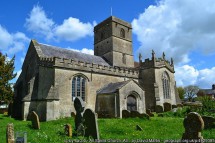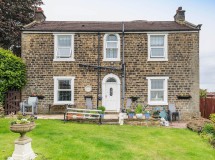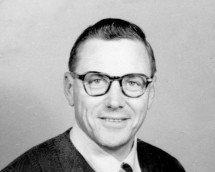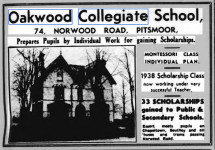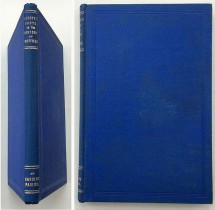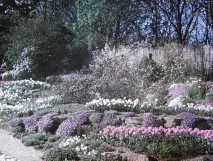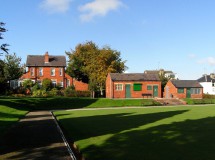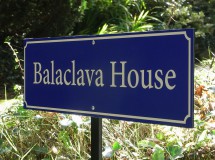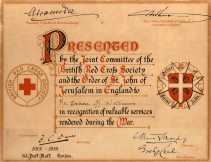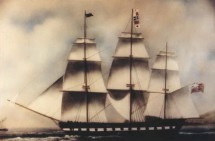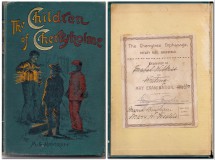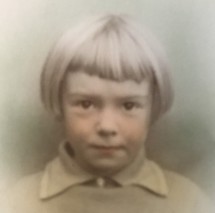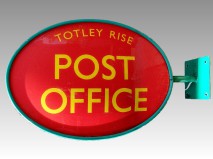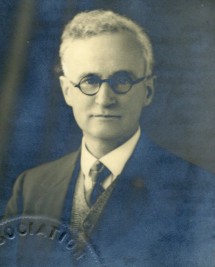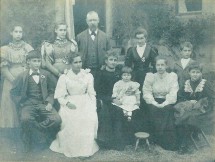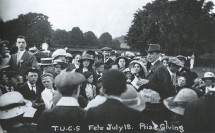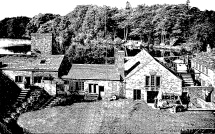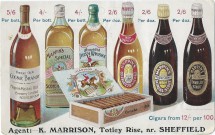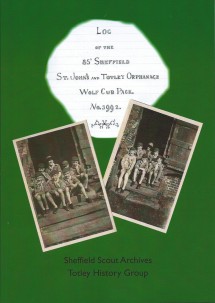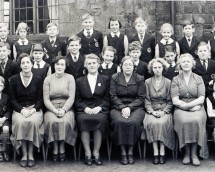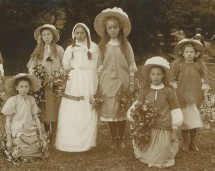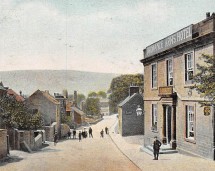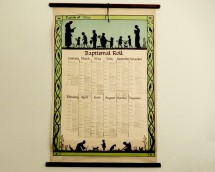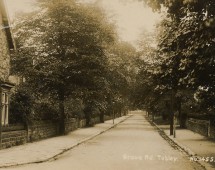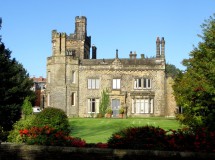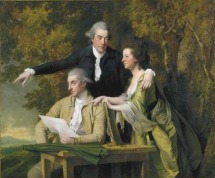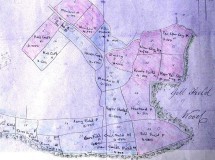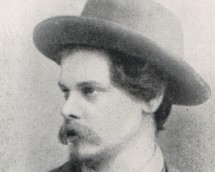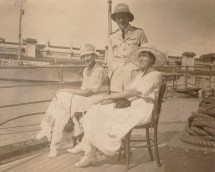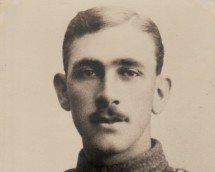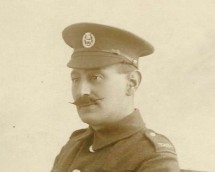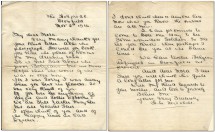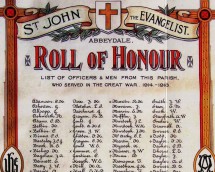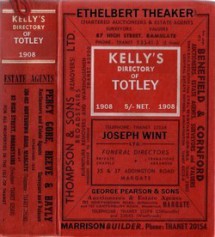WW1 Remembrance Walk
This walk visits locations that have strong associations with Totley during the First World War. It includes the homes of the ten soldiers from the village who lost their lives, the auxiliary hospitals, war memorials, and even the rifle range on which the soldiers trained. Some of these sites are just over the Totley township boundary into neighbouring Dore and Bradway which like Totley were in the county of the Derbyshire at that time. The walk is based upon research by Pauline Burnett, Jim Martin and Dorothy Prosser, whose book "Totley War Memorial WW1 1914-1918" was first published by Totley History Group in 2011.
It is also available in PDF format as an Z-fold leaflet download for home printing. Best on A3 but can be read, just about, on A4.
WW1 Remembrance Walk v1.2 8pt.pdf
Adobe Acrobat document [1.1 MB]
The walk starts at Totley Rise Methodist Church, Baslow Road, S17 4DJ, about 5 1/2 miles southwest of Sheffield on the A621 and a stopping point on bus route 97 from the city centre. There is a large car park for visitors to the church which is accessible from an entrance on Grove Road. The walk ends about half a mile further up Baslow Road at the War Memorial. The nearest bus stop is a short walk towards the city outside the Cross Scythes. The walk is entirely on paved footpaths and can be undertaken in two sections if preferred.
1. Totley Rise Methodist Church Baslow Road, west side; Roll of Honour
The Totley Rise (Wesleyan) Methodist Church has a framed WW1 Roll of Honour recording the names of those who served in the Great War, together with their regiment. A remarks column details those who lost their lives. The names of the five who died include three soldiers remembered on Totley War Memorial (Tom Fisher, Allan Hill and Bob Martin) plus two further names that do not appear on any of the memorials at Totley, Dore, Abbeydale, Holmesfield or Norton (David Cockshott and Roland Hill).
Return to the dual carriageway and turn left towards the centre centre. Immediately after the railway bridge turn left down a footpath which leads to Totley Brook Road. Cross the road and turn left.
2. Dore & Totley United Reformed Church Totley Brook Road, north side; Roll of Honour
Inside what was the Union Church, now the Dore and Totley United Reformed Church, is a roll of honour bearing the names of 3 members of the the congregation who lost their lives and a further 22 members who also served in the Great War. The names of the dead are Harold Todd and Harper Seed, both of Dore Parish, and Robert Hugh (Bob) Martin, of Glenbourne, Back Lane, Totley. The old memorial, pictured above, has recently been replaced by a more modern version as part of the renovations.
Leaving the church, turn left and walk to the intersection of three roads: Totley Brook Road, Busheywood Road and the main road which is now called Abbeydale Road South. Turn left on the main road towards the city and walk past Abbeydale Hall and the Abbeydale Sports Club.
3. Licensed Victuallers' Almshouses Abbeydale Road South, west side; Auxiliary hospital
The plaque on the northern gatepier of the almshouses indicates that they were used as an auxiliary hospital during the Great War. Being close to the VAD hospital at St. John's Church Rooms, it is probable that they were used as an overflow site for the less severely wounded Belgian soldiers.
Cross the main road at the pedestrian crossing and turn right walking along the eastern side of Abbeydale Road South away from the city. After the railway station, cross the busy Twentywell Lane and continue past Mercia Motors.
4. St. John's Church Rooms Abbeydale Road South, east side; VAD hospital
St. John's Church Rooms were built by Ebenezer Hall in 1893. During the First World War they were used as a VAD hospital. VAD stands for Voluntary Aid Detachment, and the volunteer staff were overseen by the British Red Cross Society. At the St John’s Hospital there were a hundred beds with the first wounded soldiers arriving there on the 21st November 1914. They were Belgian forces and thereafter many Belgian soldiers would pass through the St John’s doors. Dr. Charles A. Thorne, who lived at The Glen, was the hospital's surgeon; he was supported by Dr. Mary Andrews and Dr. Charles O'Connor Parsons. The President of the Dore & Totley Voluntary Aid Detachment was Mrs Sarah Milner OBE of Totley Hall whose own son, 2nd Lt. Roy Milner, was one of the first soldiers from our area to die in the Great War. Sarah Milner worked tirelessly to provide aid and comforts for wounded soldiers, including working closely with the VAD hospital at St John’s. Local people raised funds to provide boots, slippers, gloves, and other little necessities. Amongst some of the more unusual ways that the hospital was supported by Dore and Totley residents was through the very regular appeal for eggs to be donated. Food not rationed could be in short supply, and giving up precious eggs was indeed a major gesture of support for the War effort.
5. St. John's Church Abbeydale Road South, east side; War Memorial
The new parish of St. John the Evangelist was created in 1876 from adjacent parts of the parishes of Christ Church Dore and St. James Norton. The war memorial that stands in front of the church was erected on 29 Mar 1920. Thirteen of the 22 names on the octagonal base can be found on the memorials in these two older parishes and five on the war memorial in the much later parish of All Saints, Totley. Those five Totley names are Hedley Bishop, Willie Green, Allan Hill, Bob Martin and Albert Pinder. The four other names on the St. John's war memorial are: Stanley Gummer, Thomas Reginald Heap, Harold Davis and John William Masser.
Inside the church is a Roll of Honour with the names of officers and men from the parish who served during the war. Ebenezer Hall paid for six tubular bells to be erected in commemoration of the peace after the Great War. These were dedicated on Sunday 21 Sep 1919.
Continue walking out of the city along the eastern side of Abbeydale Road South until just after the railway bridge, and opposite Grove Road, you come to a small triangular shaped green. Turn left down the narrow lane.
6. Rolling Mill Cottages Mill Lane, west side; home of Hedley Bishop
Colin Hedley Bishop was born in Dore on 8 April 1893 and baptized at Christ Church, Dore on 22 October 1893. He was the fifth child and second son of Colin Bishop, a gardener, and his wife Mary Ellen (nee Kirk). By August 1897 the family had moved to Totley and in the 1901 census they were living at Rolling Mill, Totley Rise. Hedley attended Totley All Saints School until April 1906 when, at the age of 13, he left to start work. In the 1911 Census the Bishops were living in Ivy Cottage (now called Mill Cottage). Hedley was aged 17 and was working as a machine file cutter. When the First World War began, Hedley must have volunteered almost immediately and he became Service No. 2763 Private Hedley Bishop in the Queen's Own Yorkshire Dragoons. The regiment arrived at Le Havre in France on 16 July 1915 as part of the 17th (Northern) Division and were deployed to the Ypres salient. In September 1915. The Yorkshire Dragoons were involved in the Battle of Delville Wood which took place between July and early September 1915. This was a subsidiary attack of the Somme offensive and it seems very likely that Hedley was wounded during the fighting and eventually died of his wounds on 21 October 1916. He is buried in Grave K34 at Aveluy Communal Cemetery Extension. He was awarded the 1915 Star as well as the Victory Medal and British War Medal.
Retrace your steps to the main road and turn left up the dual carriageway crossing Milldale Road. Turn left down the narrow unnamed lane immediately before the crescent of shops and houses. Continue along the lane until another narrow lane joins on the right at an old farm house which is now subdivided.
7. Glenbourne Back Lane, west side; home of Bob Martin
Robert Hugh Martin was born in Walkley on 14 November 1896, the second son of Harry Martin and his wife Jeanetta (nee Biltcliffe). The family were still living in Walkley in the 1911 census but the following year they moved to Glenbourne, on Back Lane, Totley Rise. Jeanetta's aunt, Martha Hawes, nee Wordsworth, lived next door at Glenrose. Bob was a keen sportsman who played for Totley football club. He worked for Cole Brothers in Sheffield, travelling daily from Dore & Totley station. Later he became apprenticed to Hartley & Son, printers. Bob enlisted close to his 18th birthday and joined the Household Cavalry and Cavalry of the Line Regiment, Derbyshire Yeomanry Battalion, Service No. 75965, serving overseas. On 14 November 1917, Bob's 21st birthday, he was shot in Salonika, Greece. The bullet lodged in his heart but did not kill him. He rode his horse back to camp but, as there was no x-ray facility, he had to be taken by hospital ship to the island of Malta which had excellent medical equipment and facilities. At St Elmo Hospital, Valletta, pioneering surgery was performed to remove the bullet. The operation was reported in the Daily Malta Chronicle as being "the talk of the Island". Bob's operation was successful. The bullet was removed but he died of blood poisoning on 14 March 1918. He is buried in Grave Reference C. XVII. 4. in the WW1 Section of Pieta Military Cemetery, Malta.
Returning down the hill turn right and follow the lane into Laverdene Avenue. After rounding the bend cross over Totley Brook at the footbridge on your left and ascend the lane for a short distance.
8. Brook Vale Cottage Back Lane, west side; home of Allan Hill
Herbert Allan Hill was born in a cottage on Fox Lane, Greenhill in 1888. He was the third son and fourth child of William Colin Hill, a gardener, and his wife Mary Ellen Hill nee Scothern. On 24 January 1889 he was baptized at St James's Church, Norton. By 1901 the Hills had moved to Lemont Road in Totley. Allan, like his father and two older brothers, was working as a market gardener. In 1908, at the age of 20, he decided to join the Territorial Army and signed Attestation papers on 2 April and became a volunteer in 4th (Hallamshire) Battalion of the York and Lancaster Regiment. He was discharged at the end of his two year term and went back to purely civilian life working for his father's nursery business. On 11 July 1912 Allan married Mary Jane Moore at St. John's Church, Abbeydale and the couple moved into Brook Vale Cottage on Back Lane, Totley and life went quietly on until August 1914 and the start of WW1. Allan rejoined the Hallamshires on 9 August as service number 2176 Private Hill. He advanced quickly through the ranks and on 15 March 1916 he was promoted to Sergeant. On 13 January 1917 the Hallamshires sailed from Southampton for France and on 3 May 1917 they were ordered to attack the Hindenburg Line and the village of Bullecourt. This attack failed and Allan was taken a prisoner of war and he died of his wounds at Limburg hospital on 5 June 1917. He is now buried in Grave V.F.13 at Tournai Communal Cemetery Allied Extension in Belgium.
Continue to the top of the lane and turn right along Queen Victoria Road to its junction with Mickley Lane opposite the Shepley Spitfire. Turn right and ascend the rise passing Glover Road and then cross to the west side of Mickley Lane. After passing Aldam Road, turn left at the next road, Lemont Road.
9. Lemont Road south side; home of Willie Green
James William Green was the first child of James and Mary Alice Green who married in Christ Church, Dore in 1895. Willie's father was a mechanical engineer and for a short time after his marriage lived in Norton Woodseats where Willie was born on 17 December 1895. By 1901 the family were back in Totley living in Grange Terrace on Baslow Road opposite the Cross Scythes. Willie was admitted to Totley All Saints School in 1900, leaving to attend another school, probably in Dronfield Woodhouse, in November 1906. Willie enlisted in the Oxfordshire and Buckinghamshire Light Infantry on 29 June 1915 as Service No. 18960 Pte James William Green, attesting at Chesterfield. He was allocated to the 2nd Battalion of the Regiment. They were stationed in France but Willie will have spent a number of weeks training before being sent to join the Battalion, so it may well have been September or October before he reached the front. November was wet and trenches had to be repaired as they fell in. Things were reasonably quiet except for occasional shelling and sniping. It remained that way throughout the spring of 1916 and time was spent training, keeping trenches in good condition, and even playing football matches. In July the 'real war' exploded with the Battle of the Somme. On November 13th, in thick mist, a number of Brigades were attempting to take and consolidate a part of the German Front Line known as “the Green Line” and it was during this attack that Willie Green was killed. His body was never recovered but he is remembered on Pier and Face 10A and 10D of the Thiepval Memorial. His family still treasure the last letter he wrote home to his parents who by now were living on Lemont Road.
Continue walking to the top of Lemont Road and turn up the footpath passing Totley Library to the main road, Baslow Road. Turn left and left again at the next road, Main Avenue. Turn right at the first road, Sunnyvale Avenue and at the top of the road enter the well sign-posted grounds of All Saints' Church.
10. All Saint's Church Totley Hall Lane, east side; dedication stone to Roy Milner
All Saint's Church was built on land that was donated by William Aldam Milner and his wife Sarah of Totley Hall. The Milners also gave £2, 000 towards the building of the church with further funding obtained from the estate of Ebenezer Hall and from smaller public donations. The church was designed by Messrs. Currey and Thompson of Derby and building work commenced on 4 June 1923. In a ceremony on 26 July 1923 attended by the Bishop of Derby, Mr. and Mrs. Milner laid the foundation stone. There is a further inscription inside the church which is often kept locked. It reads "To the dear memory of Roy Denzil Pashley Milner 2nd Lt. Sherwood Foresters who fell in the Great War Sept. 20 1914, the east end of this Church was erected by his parents."
Leave the church grounds by the main west drive and turn left into Totley Hall Lane. Totley Hall Farm and then the hall itself are on your right.
11. Totley Hall Totley Hall Lane, west side; home of Roy Milner
Roy Milner was was born in Totley on 1 December 1892, the second son and youngest child of William Aldam Milner and Sarah Elizabeth Milner (nee Roberts), of Totley Hall. Roy was a pupil at Repton School in south Derbyshire from September 1906 to July 1911. When he left school, he joined the Army and went to the Royal Military College Sandhurst for his initial training as an officer. He obtained a commission in the 2nd Battalion of the Sherwood Foresters (Notts and Derby Regiment) on 22 January 1913 and looked forward to a promising military career. He was very popular with his fellow officers and men and he played polo for his regiment when they were stationed at Plymouth. He was also fond of hunting and he was a member of the Barlow Hunt. On the outbreak of war Sec. Lt. Milner, two other officers and a hundred men were deployed to South Shields where they took over a battleship that Armstrong, Whitworth & Company had built for Turkey but which was instead claimed by the British Government. The soldiers were on board for two days until the Royal Navy arrived to take possession of the ship. On 8 September 1914 the regiment sailed from Southampton and arrived at St. Nazaire in France on 11 September. They formed part of the 18th Brigade of the British Expeditionary Force. On 14 September Sec. Lt Milner and his men of ‘A’ company began the 350 mile march to the area around the River Aisne in Picardy. The following day the battalion marched for fifteen hours in heavy rain. The drenching rain continued as they marched for another twelve hours on the 16th. Finally, weary and footsore, they arrived at Chacrise on the 18th where they were billeted on a farm and were given a 24 hour rest period. On 19 September with three other battalions of the 18th Brigade they moved forward to the village of Vendresse in the steep-sided Troyon valley where they relieved the 1st Black Watch in the trenches. Later that day they were moved back to a reserve line. 20 September dawned wet and cold with heavy rain and sleet falling. The Sherwood Foresters joined other regiments as they attempted, with some success, to retake trenches broken into and occupied by the Germans. Roy Milner, with a fellow officer and most of their men, was cut down by heavy machine gun fire as he led a charge up the valley. On 24 September Mr and Mrs Milner received a telegram from the War Office announcing the news of Roy's death. His body now lies in Grave Ref. 6. C. 5 in the Chauny Communal Cemetery British Extension in Aisne, France.
Return up Totley Hall Lane to the cross roads at the now closed Fleur de Lys. Cross Baslow Road at the pedestrian crossing and turn left to the corner of Hillfoot Road.
12. Baslow Road cottages (demolished) Baslow Road, north side; home of Tom Fisher
Tom Brown Fisher was born on 10 October 1893 at Hallfield Farm, on Strawberry Lee Lane, Totley. He was the youngest child of Francis and Emma Fisher (nee Hill). By 1901 Tom was living in one of the now demolished cottages that stood on Baslow Road just above the corner with Hillfoot Road. Tom was enrolled at Totley All Saints School in March 1898 when he was 4 1/2 years old. In August 1907 he left school to begin work on a local farm. By the time of the 1911 census, Tom had moved out to Beeley where he was working as a cowman at Moor Farm. Tom Fisher's Army Service Record was among the 60% destroyed during the Blitz in WW2 so it is not known when he originally joined the army. When he enlisted in the Derbyshire Yeomanry in Totley his residence was given as Holmsfield so it would seem that he had moved back to work in the local area by the early years of WW1. At some point he was transferred to the 6th Dragoons (Inniskilling) and on 1 December 1917 he took part in the cavalry charge south of Villers Guislain. The Dragoons were cut down by heavy machine-gun fire and shrapnel and 169 of them died along with 271 horses. Tom Fisher was among those who died. His body was never found but he is remembered on Panel 1 of the Cambrai Memorial at Louverval.
Walk down Hillfoot Road to the corner of Summer Lane.
13. Holly Tree Cottage Summer Lane, north side; home of Jim Parker
James Parker was the third child of John Henry and Rosa Parker and was born on 8 June 1888, being baptized at Christ Church, Dore on 8 July that year. Jim was a pupil at Totley All Saints School, enrolling just before his third birthday in 1891 and leaving ten years later to begin work. He was recorded as a labourer in the 1911 census. Initially Jim enlisted with the Lincolnshire regiment but was transferred to 507th Agricultural Company, Labour Corps. This suggests that he may have been injured but unfortunately his service records have been lost. The Agricultural Companies were normally in England, the soldiers being of the lowest fitness level but providing labour on farms to help in the production of food. The 507th Company to which Jim was attached had its HQ in Beverley and he died aged 30 in Patrington Hospital near Spurn Point, where the Agricultural Company had a training camp. The cause of death, recorded by Capt. Morgan FRCS, was influenza, pneumonia and heart failure. Jim Parker was a victim of the Spanish flu epidemic that would eventually claim more lives than those lost in the hostilities of WW1. His body was brought home and buried in the family grave in Dore Christ Church. His date of death was 10 November 1918, the eve of Armistice Day.
Carry on down Hillfoot Lane and turn right into Butts Hill.
14. Moor View Butts Hill, south side; home of Albert Pinder
Albert Pinder was baptized at Christ Church, Dore on 11 March 1891, the son of Letitia (Letty) Pinder, single woman. Four years after the birth of her son, Letty married Robert Hodgson and they moved to Sutton in Ashfield leaving Albert to be brought up by his grandmother, Phoebe Hassall, and her second husband Frederick in Gleadless. In 1910 Albert married Ella Maude Hill, the sister of Herbert Allan Hill, another of the men named on Totley War Memorial. Their daughter was baptized at Christ Church, Dore, and named Phoebe after Albert's recently deceased and much loved grandmother. By the time of the 1911 census Albert, Ella, Phoebe and Frederick were living at Moor View House on Butts Hill, Totley. Albert gave his occupation as cutler although at his daughter's baptism a few months earlier he was a postman. Albert's Army Service Record is among those that were destroyed during the Blitz in World War II so it is not possible to discover when he joined the Notts & Derby Regiment but by June 1917 he was among the men of the 17th Battalion (the Welbeck Rangers), who were in the trenches in France. On the 4th June the Battalion HQ was at St Jean and took several direct hits. Albert was probably wounded during the Battle of Messines Ridge which began on 7 June 1917. He died of his wounds on 20 June 1917 and is buried in Grave II.D.67 at Mendinghem Military Cemetery in Belgium.
Retrace your steps back along Butts Hill to its junction with Hillfoot Lane. Cross towards All Saint's School and the Pinfold and turn right downhill and left into the narrow Chapel Lane.
15. The Cottage Chapel Lane, east side (now part of The Old Orchard, Hillfoot Road); home of Charles and Bernard Turner
Charles and Bernard Turner were sons of Charles and Hannah Turner (nee Bingham. The house where the family lived for three generations was a small cottage and still stands, although now part of a much larger property called Old Orchard. Born on 16 August 1892, Charles junior was at Totley All Saints School from September 1898 until leaving at the age of almost 13 to begin work. He is recorded as a scythe smith, like his father, in the 1911 census and still living at home. He enlisted in the Royal Marine Light Infantry as Private PO/1399(S), although his records are lost and dates unknown. He was killed on 17 February 1917, aged 24, on the western front south of Arras in France and is buried at Queens Cemetery Bucquoy in Grave Reference I.J.5. Born in early January 1898, the school records for Bernard Turner have not been found but he is recorded in the 1911 census as a scholar. He is named as one of the children in the Pageant of King Ecgbert, performed in 1909, and written by Mrs Sarah Milner, the mother of Roy Denzil Pashley Milner, another of the men named on Totley War Memorial. Bernard's service records have survived. He enlisted on 13 September 1916 as Pte. No. 01896 with Royal Scots 2/8th Battalion. Bernard was transferred to the 2/7th, and finally the 9th Battalion on arrival in Etaples, France on 25 June 1917. He was fighting in the Battle of Menin Road, near Ypres in Passchendale, when he was reported missing on 20 September 1917. His death was officially recorded on the 23rd with the War Office being informed the following day. He was 19 years old and is remembered at the New Irish Farm Cemetery memorial. It appears Bernard's body was found and identified in 1921 and buried there in grave reference XX.D.17.
At the bottom of Chapel Lane continue through the stoop stile on to a curving paved footpath leading down to Penny Lane. Turn left passing the riding stables and the car park of the Cricket and enter the recreation ground beyond at a small wrought iron gate.
16. Recreation Ground Penny Lane, south side; site of Field Hospital
Wounded soldiers from the front line in France and Belgium were brought to the field hospital at the recreation ground fronting Cricket Inn for treatment. More serious cases were operated on at the St John's VAD Hospital and transferred to the field hospital for recovery. A regular visitor was Dr. Rice Kemper Evans, the American Vice Consul in Sheffield, who lived at Hill Crest on Baslow Road and who had been a surgeon in Franklin, Ohio, prior to accepting an appointment in the diplomatic service in 1909. Dr. Evans's expertise was greatly appreciated we are told in Dan Reynolds's personal memoirs.
Continue up Penny Lane and turn into Lane Head Road Walk past the chicken houses of Bank View Farm and turn right into Moss Road. A short distance up the road there is a car park on the left. Follow the path at the far end behind the buildings to the field beyond. It is possible to walk along a rough path for 1000 yards uphill to the top of the Rifle Range where there are fenced off ruins.
17. Rifle Range (demolished) Moss Lane, south side; site of Training Facility
The rifle range at Totley Bents opened in 1900 on moorland that had been acquired at the foot of Totley Moss by the 1st (Hallamshire) Volunteer Battalion of the York and Lancaster Regiment. After several months of hard work and at a cost of over £4,000 a first class rifle range had been created. The corps offered every possible facility for class firing and prize shooting, to the members of the local Yeomanry, R.A. and R.E. Volunteers and, in order to encourage rifle shooting among civilians, it granted the use of the range at a nominal rental to some four or five rifle clubs that had recently sprung up including the Dore & District Rifle Club. There was an uneasy relationship between Totley and Sheffield even in those days. Colonel Hughes applied to the Council for a grant of £2,500 to finish the marking and to reduce the debt but when the Council insisted on the Hallamshires handing over control of their facility to a committee, the application was withdrawn. During the 1900s and the years immediately prior to the outbreak of war the rifle range proved to be very popular bringing thousands of people to the area as volunteer trainees, participants in shooting competitions and as onlookers. Large scale weekend encampments under canvas were common during the summer months. In 1913 the military authorities even backed an idea to build a station at the tunnel end of Totley Brook Road to provide quicker and more convenient access to the rifle range. Although a local landowner was willing to fund the erection of the station in anticipation of building a considerable number of new houses close by, opposition from other Totley residents and a lack of interest from the Midland Railway Company directors meant that the plan never came to fruition. Perhaps that was just as well from a public safety perspective as the rifle range became used for more intensive military training throughout the war years.
Return back down Moss Lane to Lane Head Road and turn right passing Monnybrook Cattery and up the hill to Baslow Road. Turn left towards the city.
18. Totley War Memorial Baslow Road, north side; War Memorial
The building of the Totley War Memorial was delayed by the difficulty of obtaining a suitable site. This was overcome thanks to the generosity of the Vicar of Dore, William R. Gibson, who donated land on Baslow Road in August 1919. The memorial was funded by public subscription under the guidance of the Milner family of Totley Hall and built by several local stone masons including Horatio Taylor. At a dedication ceremony on Saturday 27 November 1920, the War Memorial was blessed by Archdeacon E. F. Crosse. Plaques commemorate the ten local soldiers who lost their lives in World War I and the 13 servicemen and women killed in World War II. The latter was added as recently as 1983. Totley History Group has researched the lives of the WW1 soldiers and published a book entitled “Totley War Memorial WW1 1914-1918”.
For more information about the lives of the ten Totley soldiers killed in WW1 please see our subsidiary website http://riverwyre.com/totleysoldiers/
The nearest bus stop for the 97 route into the city centre is a short distance away at the Cross Scythes. Those who have parked at Totley Rise Methodist Church should continue down Baslow Road.
Search Our Website Here
September
October
November
Unless stated otherwise our meetings are held in Totley Library on the 4th Wednesday of each month at 7.30pm.
Pauline Burnett's book The Rise of Totley Rise has been revised and updated. It tells the story of this small piece of land from 1875 when there was only a rolling mill and chemical yard alongside the river a mile from Totley, through Victorian and Edwardian times, two world wars and up to the present day. It has 94 pages including a useful index and many illustrations from private collections. The book is available now from Totley Rise Post Office priced at £5, or through our website when an additional charge will be made to cover packing and postage.
A few copies are still available of Sally Goldsmith's book Thirteen Acres: John Ruskin and the Totley Communists. Totley was the site of a utopian scheme funded by art critic and social reformer John Ruskin. In 1877 he bought 13-acre St. George’s Farm so that nine Sheffield working men and their families could work the land and, to keep themselves busy, make boots and shoes. Sally tells an engaging story from our history with a quirky cast of characters including Ruskin himself, the poet and gay rights activist Edward Carpenter and Henry Swan, a cycling, vegetarian artist and Quaker. The book is available to order online from the The Guild of St. George by following this link.
A recently discovered box of WWII correspondence reveals the story of how a small group of ladies from Dore and Totley recruited knitters from the west of Sheffield and how their efforts made them the country's greatest provider of Comforts for the Minesweeping crews of the Royal Navy. The story is told in Knit For Victory, a new book from Totley History Group. Written by Pauline Burnett, it has 82 pages and many illustrations. It is on sale in local shops and via our website. Further information about the correspondence is in this inside page of our website: Dore & Totley Minesweeping Trawlers Comforts Fund.
The story is told in Totley War Memorial WW1 of the ten men from our village who gave their lives in the Great War. Written by Pauline Burnett, Jim Martin and Dorothy Prosser, a chapter is devoted to each of the soldiers with a family tree followed by as much information as could be discovered about the men and their families. There is also information about their military careers and the actions in which they lost their lives. The book has 64 pages and is illustrated throughout with photographs of the men, their families and the houses where they lived.
Totley All Saints' Church Parish Magazines for the years 1985-2006 with notices of baptisms, marriages and funerals and accounts of spiritual, educational, charitable and social matters in the village. Scanned in full, including advertisements from local traders.
In 1893 during the building of the Totley Tunnel there was an outbreak of smallpox amongst the navvies which spread to some of the local population. 17 people were buried in communal graves in Dore Churchyard, 6 from "Green Oak" (Lemont Road). The severity of the outbreak was principally caused by overcrowding and insanitary conditions in lodging houses .
Kathleen Grayson was a 39 year old housewife when WW2 broke out. She volunteered for the ARP and became an ambulance driver. During an air raid on Sheffield in July 1941, and despite her own injuries, she managed to get a seriously injured casualty to hospital. For this she was awarded a commendation from King George VI. Together with her friend Hilda Duffy, Kathleen also assembled a team of knitters to provide essential warm clothing for the men serving on the minesweepers patrolling the North Sea.
We have recently bought at auction the WW2 memorabilia of Douglas Platts whose family home was at Hillside, 98 Queen Victoria Road. After the war Douglas returned to his civilian occupation working in the family scissors manufacturing business. He lived in our area for the rest of his life.
We are very grateful to Mrs Valerie Taylor of Dore for lending us the title deeds to Lower Bents Farmhouse which is reputed to be the oldest surviving building in the area with a proven history back to 1621. We have now scanned and transcribed the deeds which could be particularly interesting to anyone with a connection to the local Fisher, Dalton and Marshall Families.
Until 1844, when Dore Christ Church parish was created, Totley township was part of Dronfield parish. We have now transcribed the burial records for former Totley residents at St. John the Baptist, Dronfield for the period 1678-1870 and at St. Swithin, Holmesfield for the period 1766-1901.
Whilst researching the history of the Dalton Family we found it useful to transcribe a number of early Wills and Inventories. These and those of many other Totley, Dore and Holmesfield people dating from between 1594 and 1856 have now been added to our website.
St. Swithin's Church, Holmesfield pre-dates Dore Christ Church and was the place where many of the people from Totley worshipped and were baptised, married and buried. Read the inscriptions on more than 750 gravestones in the churchyard including those of Mr. and Mrs. William Aldam Milner of Totley Hall, Jessie Matilda Tyzack (nee Fisher) of Avenue Farm, and Rev. J. A. Kerfoot of St. John's, Abbeydale.
Thomas Youdan was a music hall proprietor and benefactor who was living at Grove House, Totley in 1867 when he sponsored the first football knockout competition in the world for The Youdan Cup.
The words Millhouses Cricket Club can be seen in the background of team photos which are likely to date from between 1905 and the early 1920s, very probably pre-war. They were lent to us by Garth Inman who can identify his great uncle, Cecil Inman, in some of the photos and would like to know when they were taken and, if possible, the names of others present. Please take a look to see whether you can put names to any of the faces.
Josiah Hibberd was seriously injured whilst working on the construction of the Totley Tunnel in 1892. He died on 9 May 1897 at the age of 38 having apparently spent most of previous five years in hospital.
Bradway House was built around 1832 by Henry Greaves, a farmer, together with two adjacent cottages. We have traced most of the occupants of the property from these early days up to the start of World War Two.
We have transcribed the baptisms records at St. John the Evangelist, Abbeydale from when the church was consecrated in 1876 until just after the start of World War 1. The records are arranged in alphabetical order based upon the child's name and show the date of baptism, the names of the parents, their home location and occupation.
Nick Kuhn bought an original 1920s poster which had this owners' blind stamp in one corner. The stamp almost certainly refers to a house named Wigmore that was built in the late 1920s or early 1930s. The first occupiers that we can trace are John Howarth Caine, a district mineral agent for the LNER, his wife Florence Jane (nee Prince) and daughter Doris Mary. The Caine family lived at Wigmore until 1936 by which time the house would have been known simply as 12 The Quandrant.
George Griffiths died on 13 December 1888 following an explosion during the sinking of number 3 airshaft at Totley Bents. His widow Florence died shortly afterwards and his two daughters Maud and Annie were adopted separately. Whilst Annie lived the rest of her life in Yorkshire, Maud emigrated to Australia in 1923 with her husband, John Burrows, daughter Margaret and son Jack, pictured above.
George Wainwright was said to have been born in Bamford, Derbyshire in 1714. He learned the trade of linen weaving and moved to Totley after his marriage on 1744. He became an ardent follower of John Wesley who paid many visits to Sheffield and who would have passed through or close to Totley. Preaching was at first conducted out of doors and when Wesley's preachers became harassed by a mob of Totley ruffians in 1760, George offered them safety of his own home. He remained a Methodist for all of his long life, dying in Dore in 1821 at the reputed age of 107.
Oakwood School was started by Mrs Phoebe Holroyd in 1925 initially as the Firth Park Kindergarten and, by 1927, as the Firth Park Preparatory School. Phoebe was still working at the school almost fifty years later when she was well into her seventies. We would like to hear from anyone with memories of the school.
James Curtis was born at sea aboard HMS Chichester in 1790. He enlisted as a Private in the 1st Grenadier Regiment of Foot Guards in Sheffield in 1812 and served in Spain and Portugal during the Peninsular War. He later fought in France and Belgium taking part in the Battle of Waterloo. In later life James lived at the Cricket Inn where his son-in-law William Anthony was the licensed victualler. He died in Heeley in 1882 aged about 91.
Charles Paul lived in Totley in later life. He was a local historian and archaeologist who was an authority on the history of Sheffield, especially the two areas he knew best: Attercliffe and Ecclesall. His books and letters to local newspapers were published under the Latin form of his name Carolus Paulus.
Towards the end of the 19th century Totley Hall gardens became a well known beauty spot that attracted many hundreds of visitors from Sheffield on open days and the rock gardens became one of its most popular features. Mrs Annie Charlesworth sent us six glass transparencies of the rock gardens taken, we believe, in the early years following the Great War.
Anton Rodgers send us photographs of three water-colours that had been bought by his grandfather at a sale of the contents of Abbeydale Hall in 1919. One was of a scene said to be in York by A. Wilson. A second was of a seated child with a dog believed to be pianted by Juliana Russell (1841-1898). The third was of Lake Como, by Ainslie Hodson Bean (1851-1918) who lived for much of his life on the Riviera and in North Italy.
A Canadian correspondent sent us photographs of a set of silver spoons that were bought in a small town in British Columbia. The case contained a note signed by Ebenezer Hall indicating that they were a wedding gift to Maurice and Fanny Housley. We think we may have traced how they got to Canada and where they might have been since.
Green Oak Park was opened on 23 March 1929 on land that had been bought by Norton District Council from John Thomas Carr, a farmer and smallholder of Mona Villas. In later years, the buildings were used by the Bowling Club (the green having been built in 1956) and by the park keeper. However, the buildings appear to have been constructed in several phases, the oldest of which predates the park to the time when the land was used for pasture.
We believe the old Totley Police Station at 331 Baslow Road was built around 1882. Two lock-up cells were excavated just below floor level in the summer of 1890. We have traced the Derbyshire Constabulary police officers who lived there from John Burford in 1886 to George Thomas Wood who was there when Totley was absorbed into Sheffield in 1934.
David Stanley lived in Totley Rise in the later years of his life. Born in Bulwell, Nottinghamshire, he joined the 17th Lancers when he was 19 and rode in the Charge of The Light Brigade at the Battle of Balaclava where he was seriously wounded. For the first reunion of veterans in 1875, he told his story to a reporter from the Buxton Herald.
This picture postcard was addressed to Miss Abell, Holly Dene, Totley Brook Road and posted in Rotherham on 10 December 1907. Edith Annie Abell was born on 4 February 1887 in Sheffield and her family came to live in our area in the 1900s, staying for the rest of their lives.
Charles Herbert Nunn enlisted in the British Army on 23 August 1915 and was sent to France on 18 December 1915 to served with the British Expeditionary Force. In March 1916 it was discovered that he was underage and he was returned home. Shortly after his 18th birthday he re-enlisted and was again posted abroad where, in addition to this trio of medals, he was awarded the Military Medal.
This certificate was awarded jointly by the Red Cross and St. John's Ambulance to Isaac Henry Williams, of Lemont Road, for his services during WW1 as a stretcher bearer. We are seeking anyone who can help us pass it on to a living relative.
In 1832 Samuel Dean pleaded guilty to stealing a quantity of lead from the Totley Rolling Mill and was sentenced to seven years transportation to Australia. He sailed on the Mangles and upon arrival in New South Wales he was sent to work for William Cox, the famous English explorer and pioneer. After receiving his Certificate of Freedom in 1840, Samuel became a farmer and went on to have a very large family. Samuel was born in Whitechapel around 1811 to parents Samuel Dean Snr. and Susannah Duck. His descendant Sarah Dean would like help in tracing his ancestry.
Ellen Topham was born in 1889 in Nottingham. Her parents had been living together since 1862 but had never married so it was most unusual that, after their deaths, Ellen was accepted into Cherrytree Orphanage. Even more so since her father, Snowden Topham, had been acquitted somewhat unexpectedly in a widely reported manslaughter trial. Ellen remained at Cherrytree until her death from pulmonary tuberculosis at the age of 15.
Mabel Wilkes was a resident in Cherrytree Orphanage between 1897 and 1905. Her granddaughter Sally Knights sent us these images of a book presented to Mabel as a prize for her writing. Sally also sent us some personal memories of her grandmother and a photograph of a locket which contains portraits of Mabel and her husband Septimus Gale.
John Henry Manby Keighley was living at Avenue Farm when he enlisted in 1916. He fought in France with the Cheshire Regiment but after home leave in early 1918 he went missing. The Army were unable to determine whether he had deserted or returned to the front and been either killed or captured by the enemy. In August 1919 he was formally presumed killed in action but it appears he did not die but returned home to his family.
Horace Ford was admitted to Cherrytree Orphanage on 26 October 1888 at the age of six. He left at the age of 14 to become an apprentice blacksmith and farrier. Soon after his 18th birthday Horace enlisted in the Imperial Yeomanry to serve his country in the war in South Africa. His letter home to his Orphanage mentor tells of the lucky escape he had in battle.
Pat Skidmore (née Sampy) lived on Totley Brook Road from 1932 to 1948 before her family moved to Main Avenue. In this short article she remembers her time at Totley All Saints School where she was a contemporary of Eric Renshaw and Bob Carr.
As we have nowhere to exhibit memorabilia and artifacts, we have created a Virtual Museum instead. The latest addition to our collection is this double-sided Totley Rise Post Office oval illuminated sign which was on the wall of 67 Baslow Road before the Post Office business transferred to number 71. Please contact us by email if you have things that you own and would like to see added to the virtual museum.
Conway Plumbe was a man of many talents who came to live in Totley Rise around 1912. As a young man he had poems published by Punch magazine and is remembered in modern collections of WW1 poetry. A number of his paintings were accepted by the Royal Academy. An engineering graduate of London University, he joined the Civil Service where he rose to a high level as a factory inspector, publishing two books on the subject and giving a series of talks on workplace health and safety on BBC radio during WW2. In retirement he wrote a philosophical-spiritual work called Release From Time.
Inside Totley Rise Methodist Church there is a Roll of Honour commemorating the soldiers from its congregation who served their king and country during the Great War. For all but one of the 28 names the soldier's regiment is recorded in the next column. The exception is David Cockshott for whom 'killed in action' is written alongside yet he appears on no war memorial in our area and no record of a mortally wounded soldier of that name is to be found. We think we have solved the mystery.
Mrs. Kate Plumbe moved from Mansfield to Totley Rise with a number of her family in 1913 and became closely involved with the Totley Union Church. Her daughter Winifred became a missionary and headmistress in Calcutta for over 38 years following which she returned home to live with her sister Hilda on Furniss Avenue. Hilda had also been a teacher, missionary and, like her mother, a volunteer at St. John's VAD during WW1.
Thomas Glossop was a cutler and razor manufacturer who was well known amongst cricketing and gardening circles. Despite going blind, he was able to continue his hobbies with remarkable success
The Totley Union Cycling Society Prize Giving and Fete was held on the fields near Abbeydale Hall on 18 July 1914. Anne Rafferty and Gordon Wainwright have named some of the people in two wonderful photographs of the event. Can you identify any more for us?
The Tyzack family are well known in our area for owning iron and steel trades at Walk Mill, Abbeydale Works, Totley Rolling Mill and Totley Forge. This article covers the history of the family from the late 18th century when William Tyzack the founder of the company was born until the early 20th century when Joshua Tyzack farmed at Avenue Farm, Dore.
Walter Waller Marrison moved to Totley around 1897 with his wife and their two young sons. He was a house builder who constructed properties around Totley Brook and Greenoak before ill health forced him to take up less physically demanding work. In 1904 he took over the tenancy of the grocers and off licence at number 71 Baslow Road. After his death in 1908, his widow Kate and later their eldest son Jack continued to run the business until it was sold in 1934.
Ron Wijk of Nieuw-Vennep in the Netherlands has sent us two scanned images of drawings of old cottages made by the celebrated Dutch painter, Anton Pieck (1895-1987) simply annotated "Totley", and wondered whether we could identify their locations.
We would like to thank Christopher Rodgers for bringing to our attention this fascinating log of the 85th Sheffield (St. John's and Totley Orphanage) Wolf Cub Pack for 1927-45. The log is published jointly by Sheffield Scout Archives and Totley History Group as a free PDF download. It is illustrated by no fewer than 92 photographs and is supported by a comprehensive index and biographies of some of the main participants.
Following our Open Meeting event on School Days, Roger Hart, Howard Adams and John Timperley have each written to us with their memories of Norwood School, which was located in the rooms attached to the Dore & Totley United Reformed Church on Totley Brook Road.
On 22nd July 1909 the children of Dore and Totley Schools celebrated by a pageant the union of England under King Ecgbert which took place at Dore in AD 827. The pageant was devised and written by Mrs Sarah Milner and her daughter Marjorie and performed in a field close to Avenue Farm in front of a large audience. Photographs of the event survive together with a fragment of the script.
John Edward Greenwood Pinder had lived all 46 years of his life in Totley but on census night, Sunday 2 April 1911, he was not at home; he was in Derby Gaol serving a sentence of three months hard labour. From the age of 20, John had been in and out of local courts for a series of minor offences including drunkenness, assault, wilful damage and night poaching. Finally he was sent to gaol for cutting down and stealing 86 small trees which he sold in Sheffield market for Christmas.
We have already transcribed the census returns for Totley, Totley Rise and Dore. Now we have transcribed Census Strays. These are people who were born in Totley but are missing from our earlier transcriptions. They may have been living, working or studying elsewhere or just away from home on the night the census was taken. Two people were in prison. Others were in Union Workhouses, hospitals and asylums. Fully indexed strays from the 1851, 1861, 1881, 1891, 1901 and 1911 censuses are available now.
We wish to thank Gillian Walker for allowing us to digitize an archive of material about the 1st Totley Scout Group. Most of the material was collected by Arthur Percival Birley in the period 1949-51 and there are many interesting documents pertaining to the building of the scout hut on Totley Hall Lane. In addition four Newsletters survive, two from the 1940s and two from 1971.
We are grateful to Angela Waite and All Saints' Parish Church for giving us access to baptismal and kindergarten birthday rolls dating from 1926 to 1941. We have transcribed the names, addresses, birthdates and baptismal dates and created an alphabetical index of entries for you to search.
Edmund Sanderson, a Sheffield estate agent, aquired the land on either side of the old drive to Totley Grove in 1874 and divided it into plots for development. He called it the Totley Brook Estate. But before many houses were built, the estate road was severed in two by the building of the Dore & Chinley Railway line. The eastern end of the road became the cul-de-sac we now call Grove Road.
John Roberts was born in Sheffield in 1798. He became a partner in one of the leading silversmiths firms in the city before moving to Abbeydale Park in 1851 and extending the house in Victorian gothic style. He paid for the building of St. John's Church and was believed to dispense more in charity than any other person in the neighbourhood including his protege Ebenezer Hall.
The Coke Family owned the Totley Hall Estate from 1791 to 1881. With the aid of a family tree to guide us, Josie Dunsmore takes us through the story of their tenure.
When the Rev. D'Ewes Coke inherited the Totley Hall Estate in 1791 it had two farms. Josie Dunsmore tells the story of how the two farms were combined under the tenancy of Peter Flint with the aid of field maps drawn by Flint himself and later by the Fairbanks family.
Do you think you recognize this face? More than sixty photographs of the girls and teachers at Hurlfield Grammar School for Girls in the 1940s were given to Totley History Group by Avril Critchley, who was herself a student at the school. The collection includes fifteen form photographs from June 1949. There would have been a number of girls from the Totley area attending the school in those days.
Christine Weaving tells the story of her 2 x great uncle George Edward Hukin, a Totley razor-grinder, and his life-long friendship with the academic, poet, writer, and free-thinker Edward Carpenter.
Eric Renshaw (pictured here on the right with Bob Carr) grew up and lived in Totley from 1932 to 1960. Many of his memories are of a sporting nature.
We are very grateful to Gordon Grayson for giving us this splendid sale document for the Norton Hall Estates, following the death in 1850 of Samuel Shore. The estates included a large part of Totley and the document has maps and illustrations, plus schedules of land and property with the names of tenants. We have also added a transcription of the entries for Totley and Dore.
Watch this Youtube video of the talk given by Dr. Mark Frost and Sally Goldsmith on Ruskin, Totley and St. George's Farm. The talk was hosted by Totley History Group on 20th May 2015 as part of the Ruskin in Sheffield programme. Also enjoy a video of the outdoor performance Boots, Fresh Air & Ginger Beer written by Sally.
When Jacqueline A. Gibbons became interested in what made her father tick, it began a journey through WW1 archive records and led to her flying from Toronto to visit the house and village where he lived and the countryside that he so much enjoyed. Jacqueline reminds us that in the early 20th century Sheffield was a driving force of industry and that Totley was the place where many of its remarkable people lived and where they formulated their ideas.
Edgar Wood was the designer of The Dingle, 172 Prospect Road, built in 1904 for Rev. William Blackshaw, the founder of the Croft House Settlement. The house, together with its western terrace and boundary walls, has now been awarded Grade II listed building status.
What was probably "the most perfect little garden railway in existence" in 1910 was to be found in the grounds of Brook House, Grove Road, the home of its designer and constructor, Guy Mitchell. Look at some wonderful photographs and read reports in newspapers and a full appreciation in Model Railways magazine.
We have now completed our transcription of Totley School's Admission Records for the period from 1877 to 1914. There is also a useful index to the names of the scholars and to their parents or guardians. We are very grateful to Sheffield Archives and Local Studies Library for allowing us to transcribe and publish these records and for permission to reproduce the photograph of a specimen page of the register.
On 8, 9 and 11 November 2014 Totley History Group held an exhibition at Dore & Totley United Reformed Church to commemorate the centenary of the First World War. Below are additional links to some of the photographs we were lent and stories we researched especially for the exhibition.
Oscar Creswick was a local farmer who served with the Army Service Corps in Salonika and who after the war returned to Totley to become the innkeeper of the Cricket Inn and a member of the village's successful tug of war team.
Walter Evans was a market gardener who also ran a small grocery shop on Hillfoot Road when war broke out. He fought with the Machine Gun Corps at the fourth battle of Ypres. After the war, Walter ran a grocers shop at the top of Main Avenue.
Fred Cartwright was another Totley soldier who survived the Great War. He fought in France and Belgium and although he wasn't wounded he was gassed and was home on sick leave when his daughter was delivered by Nurse Jessop during a snowstorm in January 1917.
Maurice Johnson joined the Yorkshire Dragoons, a territorial unit, on 1 Jan 1914 and so was called up at the very start of the war. He fought throughout the war on the Somme, at Ypres and at Cambrai. After demobilization in 1919 Maurice returned to his old occupation in the steel industry.
Bill Glossop lent us a letter written by his father, William Walton Glossop to his wife describing life in the army during training in the north east of England and asking her to keep him in mind with the children.
The photo above provides a link to an album of photographs taken of WW1 Hospitals at St. John's, Abbeydale and the Longshaw Estate.
Nora Green, of Chapel Lane, was only 14 when war broke out. In 1914 she was ill with diphtheria and was sent to the isolation hospital at Holmley Lane, Dronfield. Nora recovered and wrote a letter of thanks to one of the hospital staff and the reply she received survives.
We have collected together on this page the names of local men who appear on various War Memorials and Rolls of Honour in Totley, Dore, Abbeydale, Norton, Holmesfield and Dronfield.
Unfortunately we were unable to identify all the photographs we were lent of Totley Soldiers. Please take a look at this album to see if you recognize any of the missing names.
This walk visits locations that have strong associations with Totley during the First World War. It includes the homes of the ten soldiers from the village who lost their lives, the auxiliary hospitals, war memorials, and even the rifle range on which the soldiers trained. Take a look at the first draft of a new walk by the authors of "Totley War Memorial WW1 1914-1918"
We wish to thank the Trustees of Cherrytree for giving us permission to publish transcriptions of the Cherrytree Orphanage Admissions Book entries for the years 1866-1929. There is also an alphabetical index for you to look at.
With more people having access to faster broadband and mobile networks, we have uploaded seven full and unedited oral history recordings and also added more short excerpts for you to listen to.
Our transcriptions of local trade directories have been expanded to cover the 95 years from 1837-1932 and have also been indexed. From the days when there were a handful of farmers, stone masons, saw handle makers & scythe grinders to the wonders of the Totley Bridge Garage Company, Betty's Boudoir and The Heatherfield Shopping Centre.
We continue to add to our Totley Newspaper Archive. Recent entries have included several about The Plumbe Family, Thomas Glossop and accidents during the construction of Totley Tunnel.
Totley Church of England Parish Magazines for the years 1922-1939 and 1948-1967 with notices of births, marriages and deaths and accounts of spiritual, educational, charitable and social matters in the village.
Around 90 photographs taken by Stuart Greenhoff for his thesis A Geographical Study of Dore and Totley including several of Totley Moor Brickworks. Superb!
Chronologically ordered snippets of information recorded by Brian Edwards during his many years of research into our local history.
Read the inscriptions on more than 700 gravestones in the churchyard.
Visitors since 24 Sep 2012:



